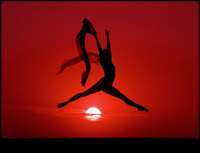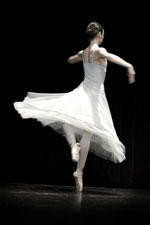 The unique challenge that ballet, or dance in general, poses to the brain is two-fold: not only is it a mind-stimulating exercise (the need to remember complex patterns of steps), but it also provides beneficial physical exercise at the same time. For adults studying ballet, this can be helpful to remember (no pun intended!).
The unique challenge that ballet, or dance in general, poses to the brain is two-fold: not only is it a mind-stimulating exercise (the need to remember complex patterns of steps), but it also provides beneficial physical exercise at the same time. For adults studying ballet, this can be helpful to remember (no pun intended!).
Pursuing the topic of the effects that dance has on the brain, I began doing an investigation on the web for studies that might address this. Among them, I found an interesting article on http://www.jewishaustralia.com/benefitsofdancing.htm, in which the “Einstein Aging Study, summarized in the June 19, 2003 issue of the New England Journal of Medicine, found that dancing helps prevent dementia.
Dementia in the study refers to both Alzheimer’s disease and vascular dementia. Vascular dementia is the 2nd most common form of dementia after Alzheimer’s.
The study …included participants in 11 physical activities including team sports, swimming, bicycling and dance.
Dance was the only physical activity that benefited the brain. This was attributed to the cerebral rather than the physical aspect of dance.
Researchers found that the relationship between the mind-stimulating effects of dancing, as well as in the above six types of hobbies, and the lowered risk of dementia remained strong even after they allowed for variables such as age, sex and education.
Frequency of activity also was important! 63% lower than that among subjects in the lowest third. We believe this emphasizes the importance of engaging in a regular program of dancing.
The need to learn and remember numerous dance movements produces a constant and very beneficial challenge to the brain.”
And, to delve into how the brain synthesizes dance and how dance likely evolved, here is an excerpt from Scientific American:
- “Dance is a fundamental form of human expression that likely evolved together with music as a way of generating rhythm.
- It requires specialized mental skills. One brain area houses a representation of the body’s orientation, helping to direct our movements through space; another serves as a synchronizer of sorts, enabling us to pace our actions to music.
- Unconscious entrainment—the process that causes us to absent-mindedly tap our feet to a beat—reflects our instinct for dance. It occurs when certain subcortical brain regions converse, bypassing higher auditory areas.”
And, lastly, Richard Powers at www.socialdance.stanford.edu/syllabi/smarter.htm discusses intelligence and dance this way:
“The essence of intelligence is making decisions. And the concluding advice, when it comes to improving your mental acuity, is to involve yourself in activities which require split-second rapid-fire decision making, as opposed to rote memory (retracing the same well-worn paths), or just working on your physical style.
One way to do that is to learn something new. Not just dancing, but anything new. Don’t worry about the probability that you’ll never use it in the future. Take a class to challenge your mind. It will stimulate the connectivity of your brain by generating the need for new pathways. Difficult and even frustrating classes are better for you, as they will create a greater need for new neural pathways.
Then take a dance class, which can be even better. Dancing integrates several brain functions at once, increasing your connectivity. Dancing simultaneously involves kinesthetic, rational, musical and emotional processes.”
Richard, you’ve hit the sweet spot. Take a dance class!

 As an adult ballet dancer – considering myself at an intermediate level – and a serious amateur at that, I think it’s worth saying that age should not be factor on whether you “feel” you should stop or get discouraged about dancing. In this blog, I am going to share with you my experiences on how I keep myself healthy to maintain limber joints and muscles so I can continue dancing.
As an adult ballet dancer – considering myself at an intermediate level – and a serious amateur at that, I think it’s worth saying that age should not be factor on whether you “feel” you should stop or get discouraged about dancing. In this blog, I am going to share with you my experiences on how I keep myself healthy to maintain limber joints and muscles so I can continue dancing.